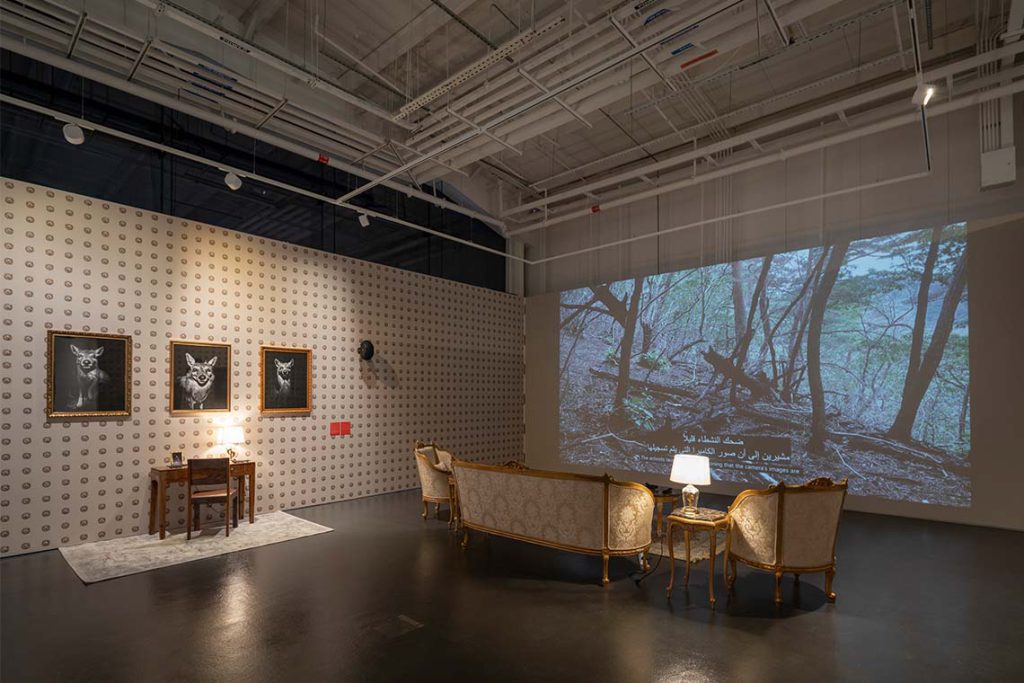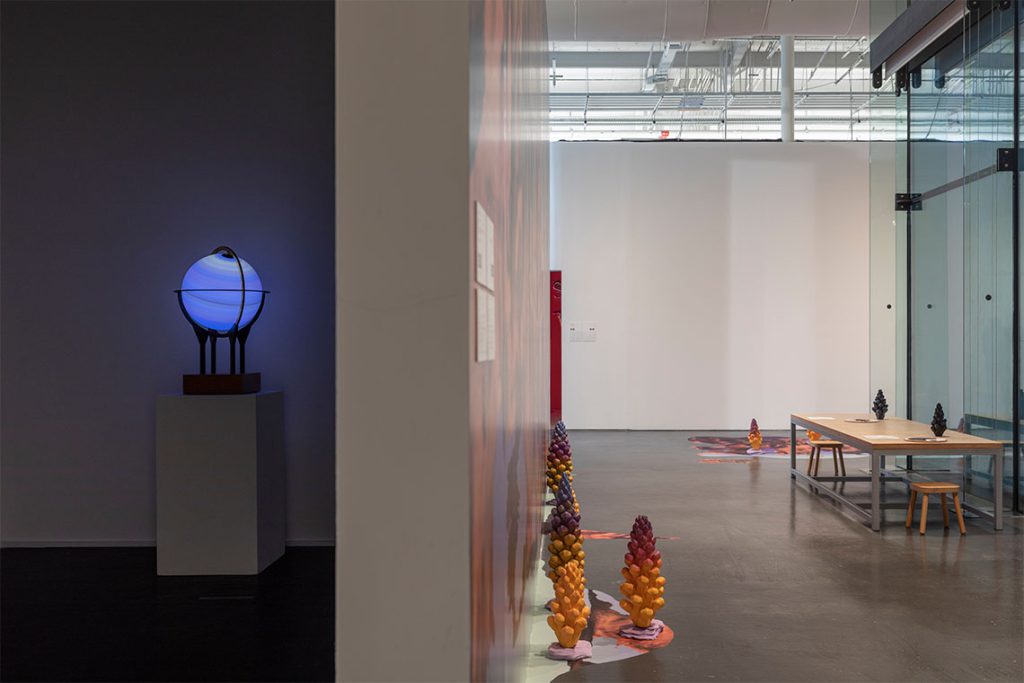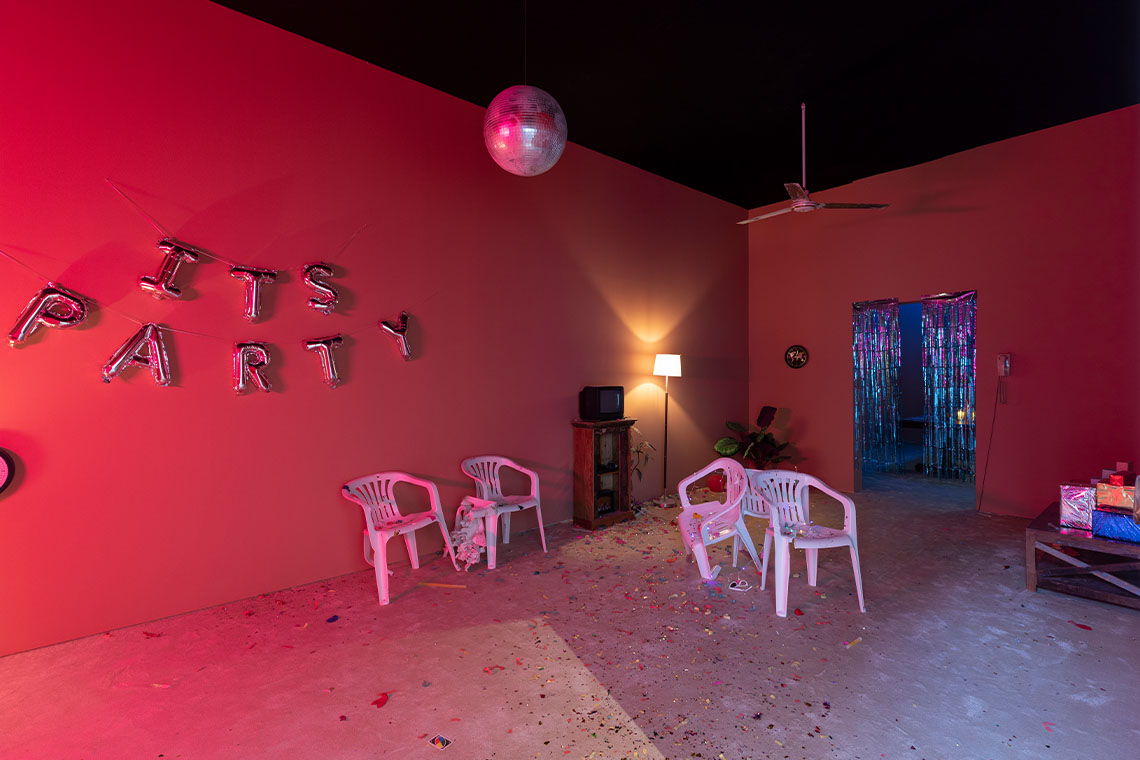Against the backdrop of the recent COP28 in Dubai, the exhibition Nine Nodes of Non-Being at Abu Dhabi’s 421 offers an unexpected approach to the unknown of our extinction. What does it mean to face an event that will not only kill our bodies but also end our culture, our imagination, who we are?
Nine Nodes of Non-Being is not about climate anxiety, or the panic of imagining our individual deaths. For curator Ritika Biswas, the impending apocalypse caused by climate change “actually opens up terrains of wildness, of collaboration, of thinking, of imagining of creating, and co-making with other human and non-human species and bodies” in ways that other lenses through which to approach the world might not allow. The collection of nine artists’ works looks rather at the state of non-being or negation, she says, as a generative space where imagining the end reveals the potential for something to begin.
As much a thoughtful exercise of curatorial will as an excavation of what it means to face the unknown, Nine Nodes is the result of Biswas’s time in 421’s Curatorial Development Program, in partnership with the Bombay Institute for Critical Analysis and Research (BICAR). The programme’s first iteration, with the theme of Screening Screaming: (Human) Nature in Crisis, led the cohort through a months-long colloquium of research presentations and discussions with scientists, researchers and artists, including Ho Rui An and Jitish Kallat.
The exhibition opens with one of two installations that most strongly materialise its thesis – that if we allow ourselves to sit with our existential dilemma, perhaps we can somehow grasp the incomprehensibility of extinction. To that end, Biswas deploys something resembling an old aunt’s living room, a familiar environment that soon reveals the uncanny valley.

Wunderkammers house photographs of almost-recognisable creatures generated by AI. Pieces of bark strewn around the living room are inscribed with words that, upon closer inspection, are only jumbles of characters. The curator’s hand is hard at work to evoke our own collective hand in creating something that we don’t quite recognize from the Earth we have always known. A film by UNMAKE LAB, the artistic duo responsible for the photographs, is the installation’s centrepiece and features other AI-generated animals created from photos captured by trail cameras, as real animals escaped a mountain forest fire. The limitations of technology’s ability to present truth force us to consider our inability to imagine our own future (or non-future).
Mariam AlZayani’s Post-Anthroparty (2023) similarly tunes the viewer to a hidden realm of being. In the artist’s Lynchian world, the table is set and games are laid out for a party, but impure fragments — like the leftovers and ruins of a Giulia Cenci artwork – make the whole thing seem a bit off. Numerous clocks show varying times, free from the march of capitalism and human beings altogether. Plastic chairs are inexplicably melted together. A television shows only the word ‘fin’, the work’s most obvious gesture.
That the message is clear with this work is a good thing. Like the exhibition in its entirety, Post-Anthroparty forces us to confront the threat we face, so that gracious curatorial movements can open us to new ways of imagining a state of non-being. Zara Mahmood’s hazy stills from videos of the sky and her spartan line drawings offer a place to rest after UNMAKE LAB’s anxiety-ridden opener. Botanic forms and decorative architectural elements contend with modernism’s rejection of ornament in Amba Sayal-Bennett’s attempts to commune with otherness. Meanwhile, Fayçal Baghriche’s luminous globe spins too fast for countries or even continents to be distinguishable, calling to mind both rising seas and the liquifying of political entities as the climate apocalypse unfolds.

At the exhibition’s centre, Apichatpong Weerasethakul’s Vapour (2015) has at first glance much in common with Béla Tarr’s melancholy worlds, as masked villagers go about their business indifferent to a creeping fog, and the film’s silent compositions imbue the Thai countryside with an apocalyptic feel. The violence of a changing environment feels barely suppressed in the film, and the space of non-being not easy to uncover. This is true, as well, for Clemencia Echeverri’s Treno (2007), a video screened on glass facades, which can only be seen at night. I visited it during daylight hours, but the installation’s sounds of flowing water and the cries of drowned political dissidents were clearly audible. Malik Irtiza’s Whispers from the Void (2023), discoverable both throughout the exhibition and on the grounds of the 421 campus, is an installation of tongue sculptures and recordings played backward. The complicated narrative they symbolise, rooted in multiple languages and histories, traces the breakdown of language and the void left by psycho-social loss, encouraging us to commune and remember in this space of negation.
Ayman Zedani’s The Keepers (2022) coalesces the artist’s research on parasitic desert plants, DNA and interspecies theory. Sculpture and research materials tell the story of future plants that have taken on the genetic material of other now-extinct plants, in order to become more resilient, inadvertently becoming the keepers of non-human genetic information. Careful not to fetishise a speculative science-fiction future, Zedani’s venture into territories of non-being resembles a 19th-century botanical drawing. Whether beautiful or appalling, it merely classifies a plant indifferent to the existence or nonexistence of human beings – that is, unless it makes use of the human genome.
In many Anthropocene exhibitions, we are used to looking at the violence that we as humans have inflicted upon the world, feeling guilty and being compelled to act in some way. Or, we see the speculative and the possible in alternative imaginaries of a world an exhibition wants us to work toward. “I’ve found that this oscillation between hope and trauma,” Biswas says, “is not the most effective, at least not for myself, and maybe not the most nuanced.” Nine Nodes deftly offers a reprieve from the spectrum of approaches to the climate crisis by allowing us to indulge in another state of existence altogether.



